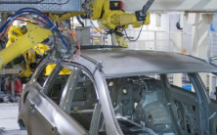
At the crossroads of transformation, the automotive industry faces a pivotal moment, navigating recent setbacks amidst global challenges. Drawing insights from GiGroup Holding’s latest global research, this blog investigates the future challenges, key trends, technology’s impact, strategies for managing skill shortages, the key skills of tomorrow, successful international recruitment practices, and the evolving landscape of gender equality. From consumer hurdles to seizing opportunities in electric vehicle adoption the industry is undergoing a transformation. As the workforce undergoes a profound shift, demanding new skills, and businesses strategize global recruitment, inclusivity and diversity take centre stage.
Understanding the Challenges
The automotive sector, a dynamic landscape known for its innovation and resilience, has found itself at a crossroads in recent years. As we delve into the state of the automobile industry, it’s clear that the road ahead is both challenging and brimming with transformative opportunities.
A Bumpy Ride for car manufacturers: Auto industry trends
Over the previous years, the automotive sector has experienced a decline, marked by a loss of revenue and a dip in manufacturing. Unique challenges, catalysed by the global economy and exacerbated by the COVID-19 pandemic, have come to the fore.
- Perception and Pricing: As customers grapple with economic challenges, consumer decisions are swayed by the perception and pricing of fuel sources, leading to deferred or cancelled vehicle purchases and a reduction in car sales.
- Electric Vehicle Apprehension: Doubts surrounding electric vehicles impact car sales, with potential buyers grappling with uncertainties about vehicle performance.
- Component Price Hikes: Escalating prices for manufacturing components prompt automakers to reassess their material choices.
- Shifting Mobility Habits: Changing consumer habits, embracing rental and ride-sharing over ownership, impact traditional sales.
- Material and Chip Shortages: Raw material and semiconductor shortages force manufacturers and car companies to rethink vehicle components.
The pandemic acted as a catalyst, contributing to material shortages and a notable reduction in commuting, further impacting automobile sales.

As part of our research, we asked both Automotive and non-Automotive workers ‘What do you think is the best sector to work in?’ Looking at the aggregated scores of both groups, the Automotive industry ranked 12th – a clear indicator that it has challenges with its reputation.
Download our Free Automotive Global HR Trends Report

Navigating the Numbers: Financial Overview of the industry
The financial trajectory of the sector reflects this turbulence. The decline, which commenced in 2020, saw total revenue drop by 9% from $2.88 billion in 2019 to $2.52 trillion in 2022. A slow recovery is underway, with expectations to reach $2.56 trillion in 2023. Sales volumes mirrored this rollercoaster, with a sharp 13.9% drop in 2020, only to rebound to 81.4 million units in 2021.
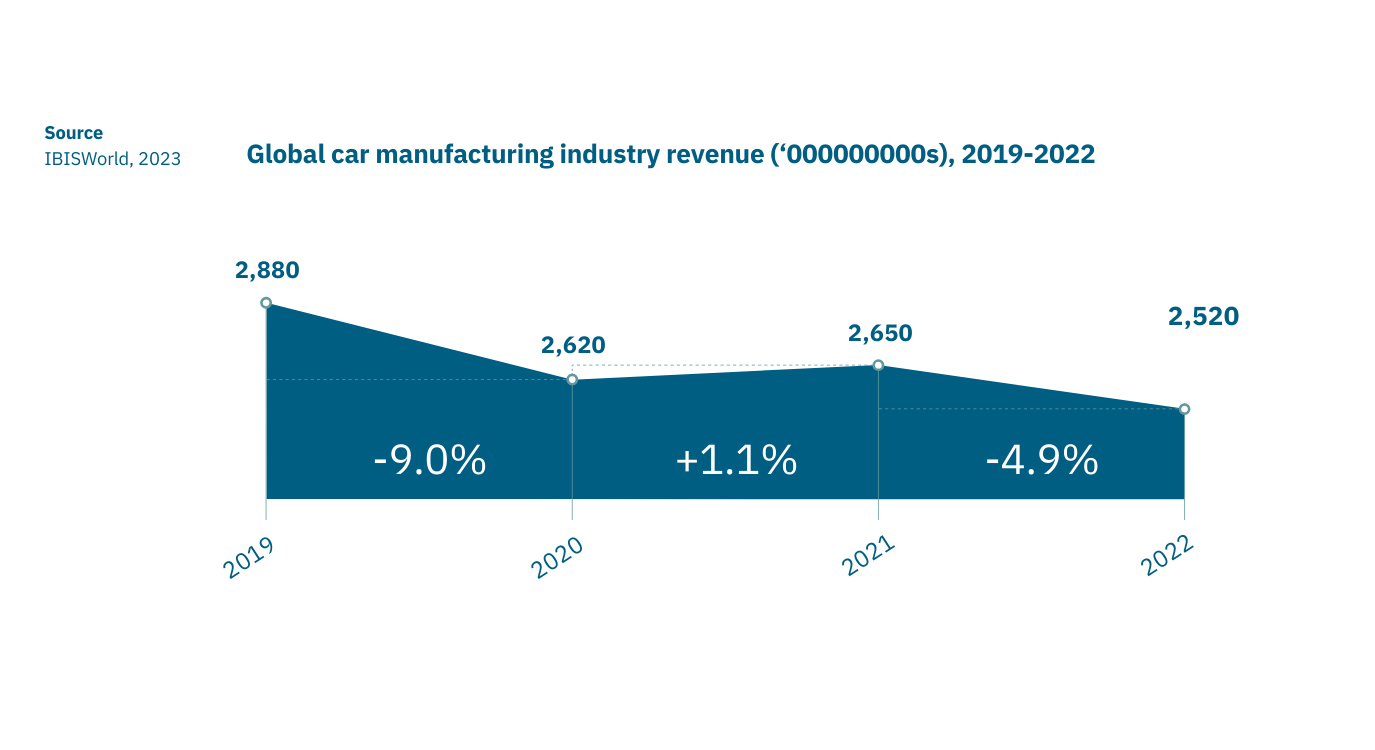
Evolving Horizons: A Glimpse into the Future
Championing Change: From Technological Breakthroughs to Autonomous Vehicles – Embracing Innovation and Sustainability
Long perceived as stagnant and male-dominated, the automotive industry is on the cusp of transformation. Logistical and legal pressures are compelling businesses and automobile manufacturers to update their products, while consumers re-evaluate their preferences.
- Rise of Electric Vehicles: Consumer preferences are evolving, driving a worldwide shift and a surge in electric vehicle sales. In 2022, manufacturers sold 10.52 million electric and plug-in hybrid cars, marking a 55% increase from 2021.
- Surge in subscription models: A digital era sees consumers embracing subscription models, propelling the subscription-based automotive industry to an anticipated $12 billion by 2027.
The automotive industry is witnessing a surge in car subscription models, with manufacturers like Audi, Lexus, Nissan, Porsche, and Volvo, along with third-party providers, embracing flexible terms that often include insurance and maintenance. Additionally, third-party providers, including car rental companies, are embracing new forms of business models and extending their services to include subscriptions. Shared vehicles and car sharing aim to also significantly reduce mobility costs through a more efficient utilisation of expensive mobile assets.
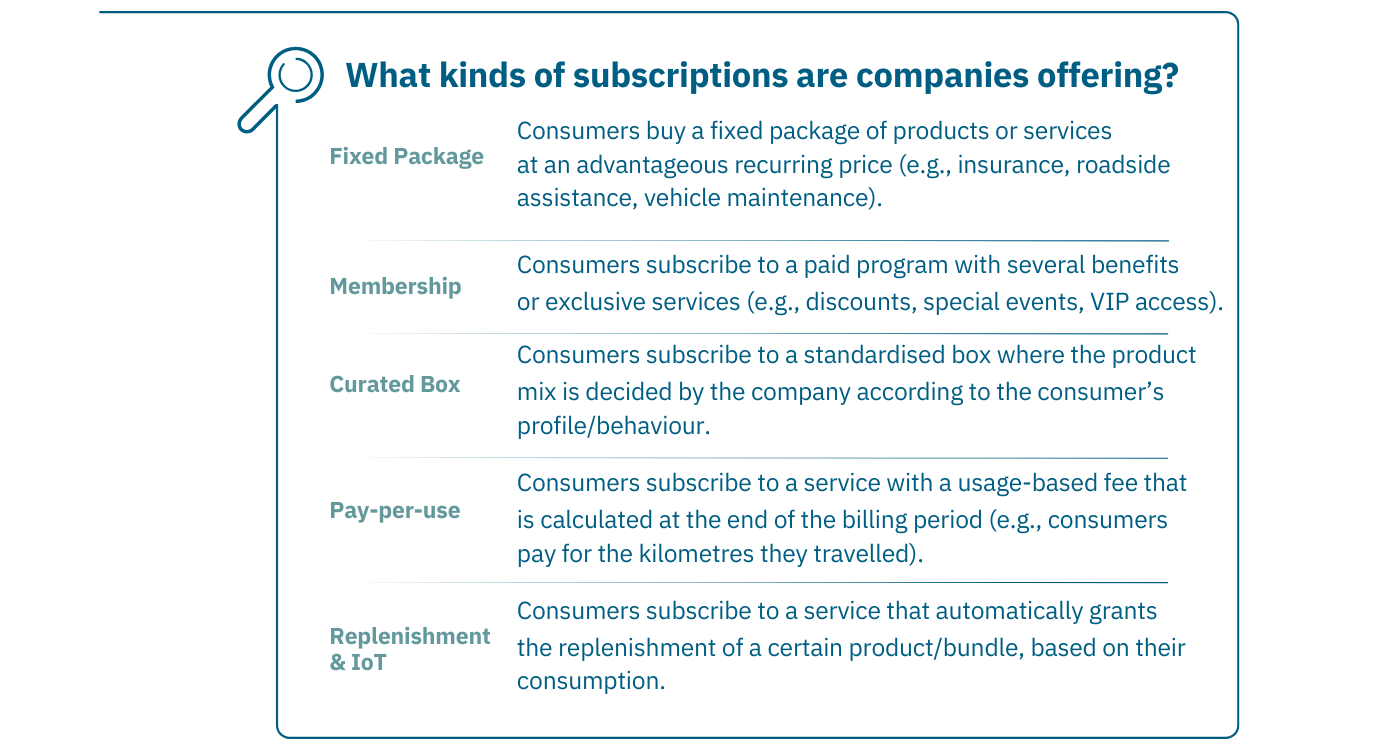
- Pressure for Carbon Emission Reduction: Governments globally are championing sustainability, with 36 countries implementing Net Zero programs and stringent legislation phasing out internal combustion engines (ICEs).
- Technological advances and breakthroughs: The quest for better driving experience, more transportation options that align with climate change initiatives and less reliance on public transportation continues.
Driving automation through Connected and Autonomous Vehicles (CAVs) also referred to as self driving cars / autonomous cars that require no human intervention, micromobility vehicles and advanced driver assistance systems are set to redefine the automotive landscape, with potential value in the billions. This shift demands expertise in autonomous vehicle engineering, data science, artificial intelligence and cybersecurity.
Key automotive industry trends, opportunities and Challenges: The Blue-Collar Perspective
The winds of change also bring opportunities, particularly for blue-collar workers. Remanufacturing, the renovation of used or defective parts, emerges as a growing sub-industry. With a market growth size expected to reach $124.62 billion by 2030, this sector offers benefits such as increased profits, reduced consumer costs, environmental sustainability, and a surge in job opportunities for blue-collar workers.
Battery Recycling: A Sustainable Revenue Stream?
As electric cars gain prominence and enjoy growing demand, the spotlight turns to battery recycling. Electric vehicle batteries, even after their primary use, retain significant capacity. Car manufacturers and remanufacturers eye this as a revenue opportunity, but challenges loom. Clear guidelines on repackaging, certification, standardisation, and warranty liability are essential, with ongoing updates such as the European Union Battery Directive providing crucial guidance.
Unravelling the Impact of Technology Developments on the Automotive Industry and its workforce
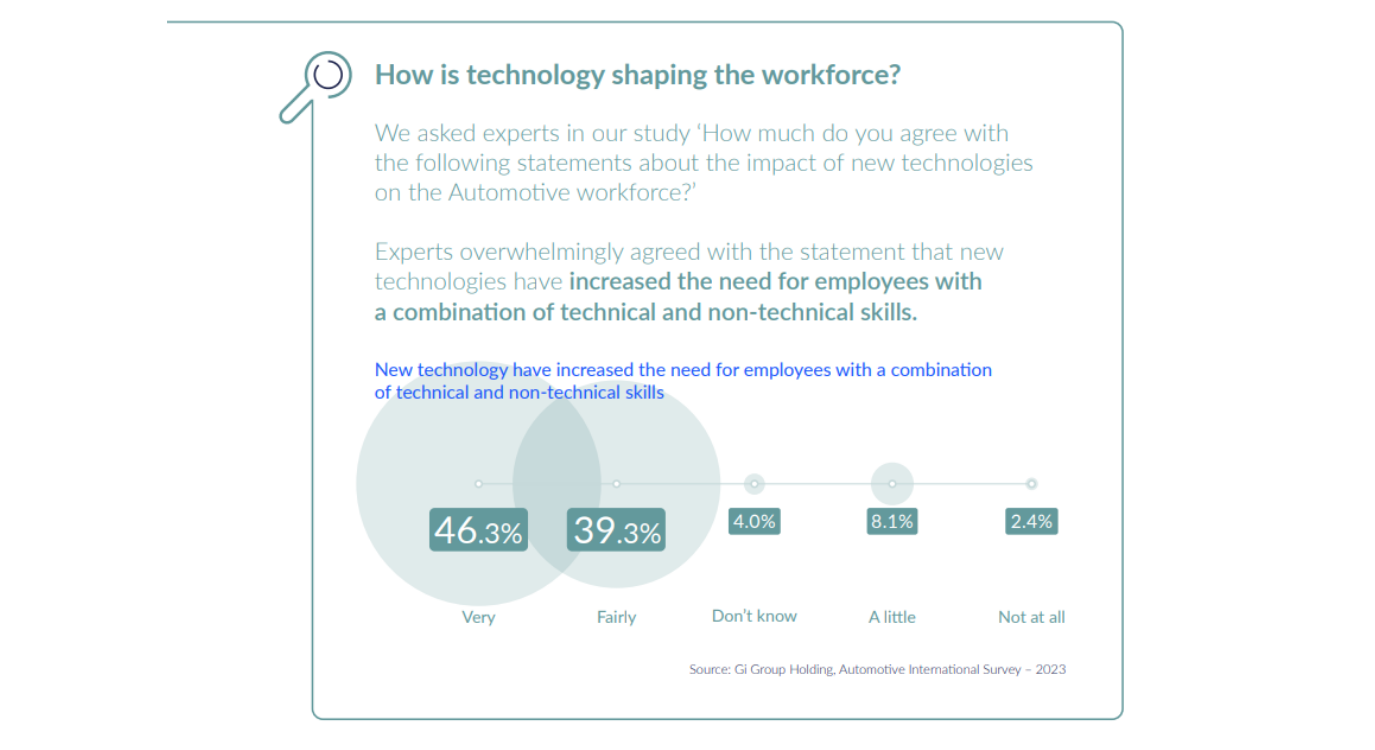
In the ever-evolving landscape of the automotive sector, technological advancements are reshaping the very foundation of the industry. As we explore the transformation, we unravel how new technologies are not just changing the concept of cars but are profoundly impacting the workforce that propels this sector forward.
Redefining the Car: From Status Symbol to Sustainability Focus
The perception of cars is shifting, especially among younger generations who view traditional, powerful vehicles as both environmentally hazardous and impractical for modern life. This change is not merely a response to shifting consumer desires but is also propelled by governments’ ‘Net Zero’ pledges, ushering in legislative changes restricting gas-powered vehicles.
This transformative shift towards electric vehicles, while heralding a greener era, is also triggering new challenges and seismic changes within the automotive workforce.
Managing Workforce Changes in the Age of Electric Vehicles
Reduced Components, Evolving Workforce
Electric vehicles, characterised by fewer components, signal a reduced reliance on traditional manual workers who historically played a pivotal role in vehicle assembly. As automotive companies pivot towards electric vehicles, the demand for a different skill set becomes paramount.
Tech-Savvy Workforce in High Demand
Modern consumers demand seamless integration of products with technology ecosystems, and automobiles are no exception. The industry is witnessing a surge in demand for technical workers proficient in software engineering, data science, and connected technologies.
Streamlining Manufacturing Processes
Beyond the vehicles themselves, automotive companies are embracing new technologies to streamline and automate manufacturing processes. This not only ensures efficiency but also reshapes the nature of roles within the industry.
Which Jobs Are Changing Due to Technology?
Automotive decision-makers identified manual workers (57.3%) and engineers and designers (54.6%) as the most heavily impacted sections of their workforce due to new technologies.
Global Variations in Technological Impact
Regional differences emerged in the impact of technology on automotive workforces. Hungarian workers reported the highest impact, while Japanese workers reported the lowest. Interestingly, in France, Germany, and Japan, engineers and designers felt a greater impact than manual workers.
Empowering Experience with Technology Technology as a Bridge for Older Workers
Technology is not only shaping the future but also acting as a bridge for older workers. Advances in robotics and exoskeletons are enhancing the capabilities of older blue-collar workers, enabling them to contribute to roles that might have been physically challenging.
Revolutionising Physical Tasks
Innovations like lifting and material handling devices, exoskeletons, intelligent tools, and collaborative robots are transforming physical tasks, creating an inclusive environment for workers of all ages.
Tomorrow’s Workforce: Anticipating Demand and Reskilling in Blue-Collar Jobs
Looking ahead, professionals foresee increased demand for mechanical technicians (42.7%) and maintenance technicians (41.2%) in the next five years, emphasising the importance of technical skills in blue-collar roles.
Global Variations in Demand
While trends are similar across countries, unique demands surface:
- CNC machine operators top the list in the USA, Poland, Spain, and China.
- Poland anticipates high demand for car transport drivers.
- The UK highlights material managers as a key role.
The Evolving Landscape for White-Collar Workers
Demand for White-Collar Roles in the Technological Age
As technology reshapes the automotive landscape, the demand for white-collar roles is also evolving. Respondents identified automotive engineers, IT specialists, and data specialists as the most in-demand roles.
Global Perspectives on White-Collar Demand
Variations in demand for white-collar roles across countries reveal nuanced preferences:
- France, Germany, and Hungary prioritise Research and Development managers.
- Germany stands out with HR managers in its top three roles.
- The UK highlights Quality Control managers and Sales and Marketing Managers.
One thing is clear: adaptability is the key to navigating the future. The industry is not just witnessing a shift in the vehicles it produces but also in the very fabric of its workforce.
From blue-collar workers embracing technology to white-collar roles adapting to the demands of innovation, the automotive sector stands at the intersection of tradition and transformation. As technology continues to reshape the auto industry, those who embrace change will not only survive but thrive in the era of the tech-driven automotive revolution.
Evolving skill requirements: Managing Skills Shortages in the Automotive Sector
In the dynamic world of the automotive industry, innovation is steering the wheel, propelling the sector into uncharted territories.
Accelerating Shifts: The Demand for Specialised Skills
As the automotive landscape transforms, the need for specialised skills is becoming more pronounced. The surge in demand for electric vehicles is reshaping the talent pool, with automakers vying for experts in electric vehicle engineering, battery technology, and charging infrastructure. Simultaneously, the industry is navigating the complexities of autonomous driving and advanced driving assistance, requiring a robust infusion of software specialists and computer engineers.
Software Engineer Shortage: A Global Challenge
As vehicles become more software-defined, automakers are recognising the need to transform into software companies. But the race to integrate cutting-edge technologies into automotive products faces a significant roadblock— there’s a global shortage of software engineers. Experts predict this shortage will escalate to 1.2 million by 2026. Despite this impending crisis, a 2020 survey revealed that only 30% of automotive supply firms felt confident in their capabilities to respond to these trends. Alarmingly, a mere 9% prioritised recruiting for crucial roles like software architects, developers, and system integrators.
Skills Challenges in Automotive Manufacturing
The evolution of the automotive manufacturing industry brings forth new products and business models, demanding workers with specialised skill sets. However, 31% of businesses in the industry cite growing labour costs and skills shortages as significant challenges. Within this landscape, 56% of companies report specific skills shortages, while 48% express the need for entirely new skill sets.
Insider Insights: Voices from the Industry
“Smart working, and the possibility of hiring remotely engineers from around the world, paves the way for the acquisition of new skills beyond national borders. This can help satisfy the demand for otherwise vacant job positions, effectively reducing the phenomenon of candidate shortage.”
Marco Santucci
Chief Executive Officer, Jaguar Land Rover Italia
Navigating Blue-Collar Skills: A Blueprint for the Future
Key Skills for Blue-Collar Positions
Anticipating the future demands of blue-collar jobs, our study reveals a shift in priorities. While mechanical skills remain crucial, there is a growing emphasis on technical proficiencies. Electrical and electronic expertise (47.2%) and technological proficiency (46.3%) top the list, showcasing the industry’s trajectory towards digitalization. Additionally, data analysis and interpretation (35.4%) secure a prominent position, reflecting the evolving nature of blue-collar roles.
Adapting to Blue-Collar Skill Demands
Companies are taking proactive measures to address the evolving skill requirements. Internal programs for “functional mobility” and “training paths” are equipping blue-collar workers with diverse skills, enhancing their profiles and versatility. Digital literacy is increasingly critical, enabling workers to manage machinery, analyse production data, and navigate the digital tools prevalent in the automotive industry.
Global Variation in Skill Demands
While understanding of mechanics remains a top priority across seven out of ten countries, distinctions emerge. The UK, Hungary, China, and Brazil prioritise digital literacy, recognizing its pivotal role. Italy, Germany, Spain, and China place importance on data analysis and interpretation.
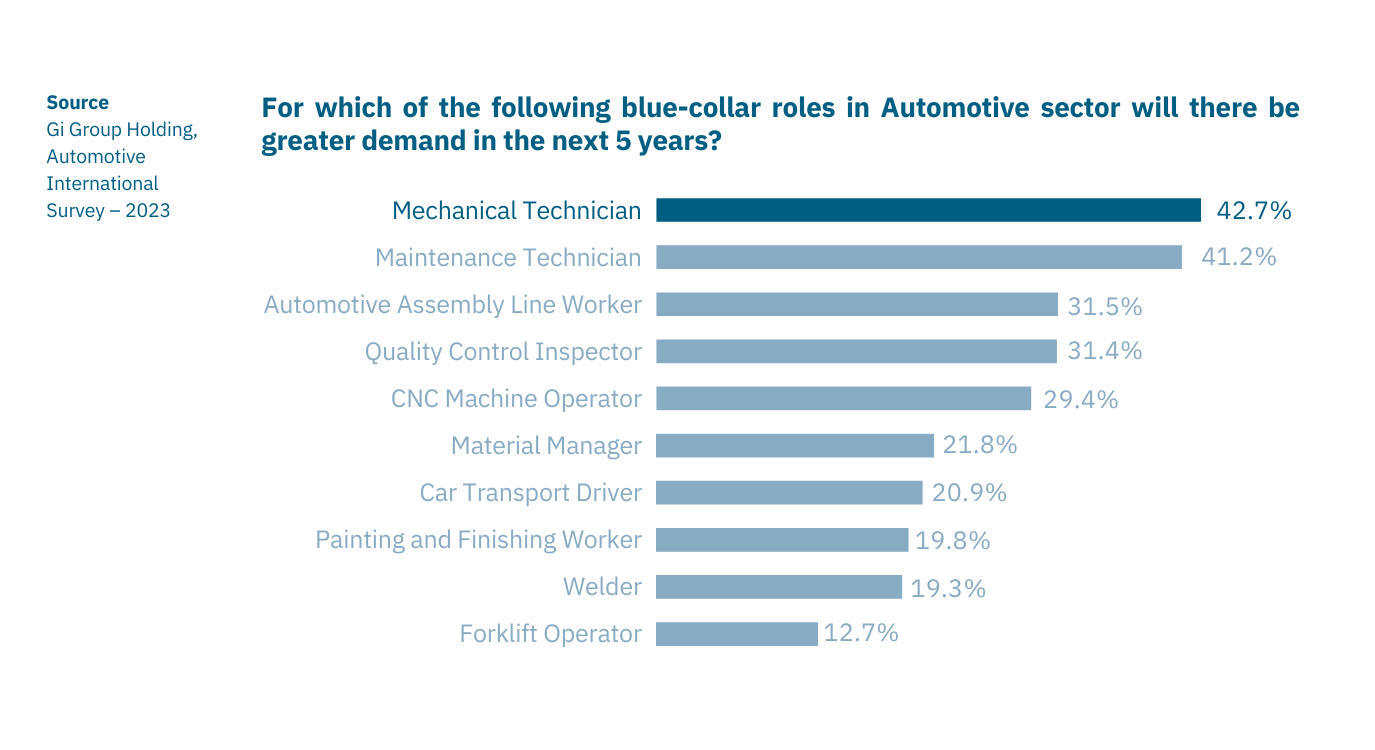
Evolving Landscape for White-Collar Skills: A Demand for Innovation
In-Demand Skills for White-Collar Positions
As the automotive industry propels towards innovation, the demand for white-collar skills mirrors current trends. Electric vehicle technology, AI, and machine learning skills, and sustainable technologies emerge as the top three in-demand skills. However, variations across countries shed light on nuanced preferences, with France and the USA prioritising data security and privacy.
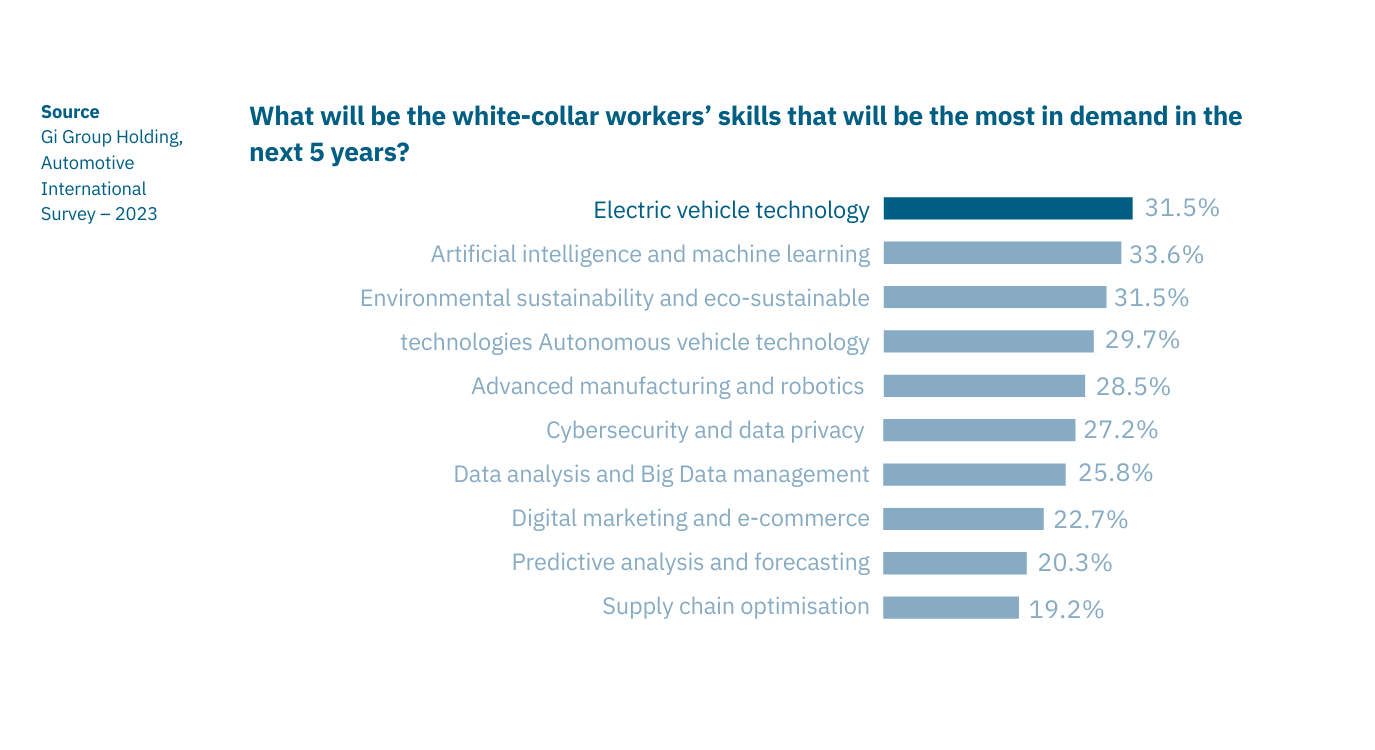
Insights into White-Collar Skill Demands Across Countries
- France and the USA highlight Data Security and Privacy in their top three.
- Despite impending EU regulations on CO2 emissions, neither France nor Germany prioritises Electric Vehicle Technology.
- The UK stands out with Predictive Analytics, Forecasting, and Data Analysis in its top three.
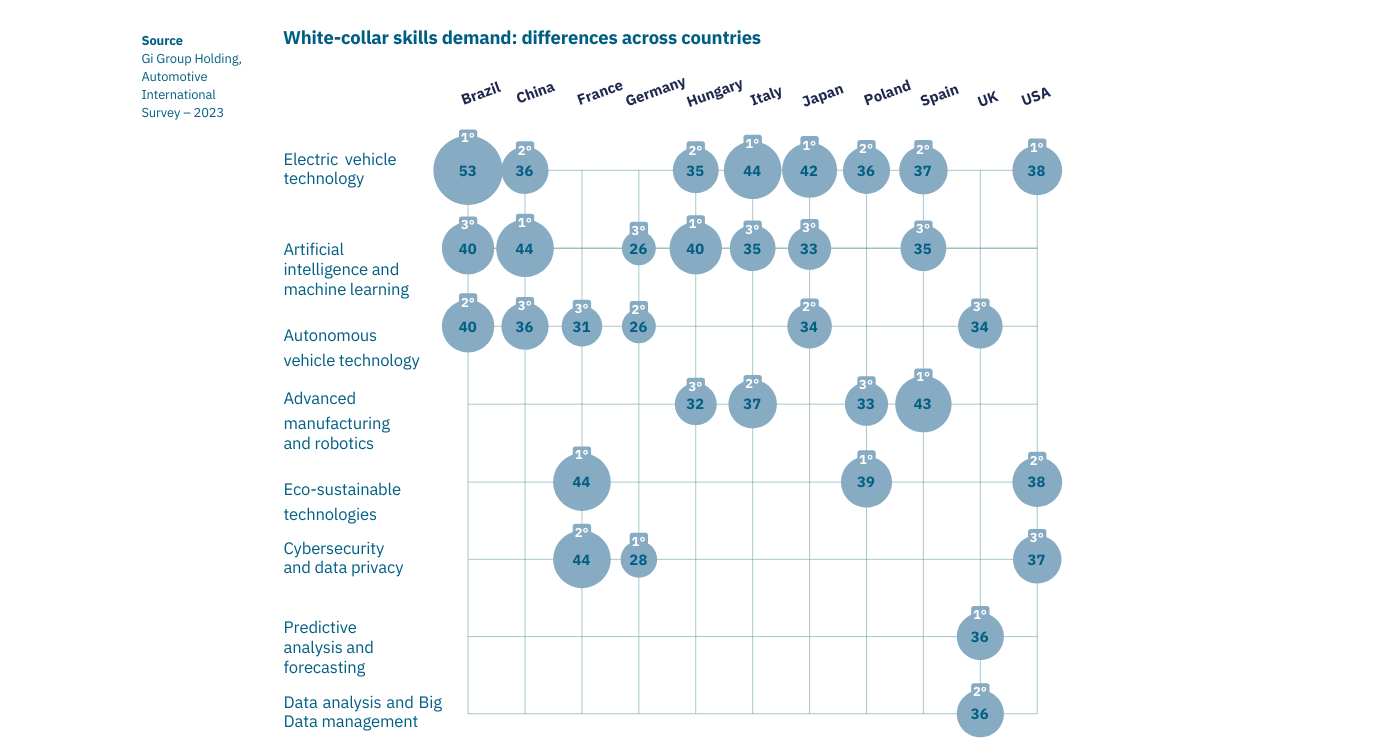
Strategies for Skills Shortages: Upskilling, Reskilling, and Beyond
Addressing Skills Challenges: A Holistic Approach
The automotive manufacturing industry acknowledges its challenges and is proactively responding. In 2022, 58% of businesses initiated training, upskilling, and education programs. A significant portion (20%) focused on in-house training. Remarkably, only 8% attempted to attract skilled employees through increased pay, signalling a prioritisation of investing in existing employees over salary competition.
Upskilling Initiatives and Their Focus
Responding to the skills shortage, companies are rolling out a diverse range of training initiatives. Digital skills training (39.1%) and workshops and vocational training courses (36.6%) take centre stage. While commendable, it remains unclear if these programs sufficiently address the specialised skills needed for advancements in artificial intelligence, autonomous driving, and other key areas of innovation.
In conclusion, the automotive sector is at a critical juncture, facing unprecedented challenges and opportunities. As technology propels the industry forward, the success lies in the hands of those who can adapt, innovate, and bridge the skills gap. The road ahead may be uncertain, but for those who embrace change, the journey promises innovation, growth, and a sustainable future for the automotive workforce.
Charting the Course: Strategies for International Recruitment Success
We shift gears to explore the potential solution of international recruitment to address the pressing skill and labour challenges faced by companies in the industry. As the demand for specialised talent intensifies, particularly in regions like the USA grappling with labour shortages, the prospect of tapping into untapped talent pools abroad becomes a compelling strategy.
The Dynamics of International Migration
Motivators for International Migration
Understanding the dynamics of international migration is crucial for automotive companies considering global recruitment. Factors such as income disparities, wage differentials, and opportunities for socioeconomic advancement emerge as primary drivers of migration. Notably, migrants tend to gravitate towards countries offering higher incomes, providing significant advantages to destinations like the USA, UK, and France.
Trends and Considerations in Migration Patterns
While wealthier nations remain attractive to migrants seeking higher income, trends reveal that migrants from economically challenged countries often migrate to nearby regions. This phenomenon is influenced by factors such as the cost of living disparities, language barriers, cultural considerations, and familial ties. Automotive companies embarking on international recruitment endeavours must navigate these nuances to create programs that resonate with potential migrant workers.
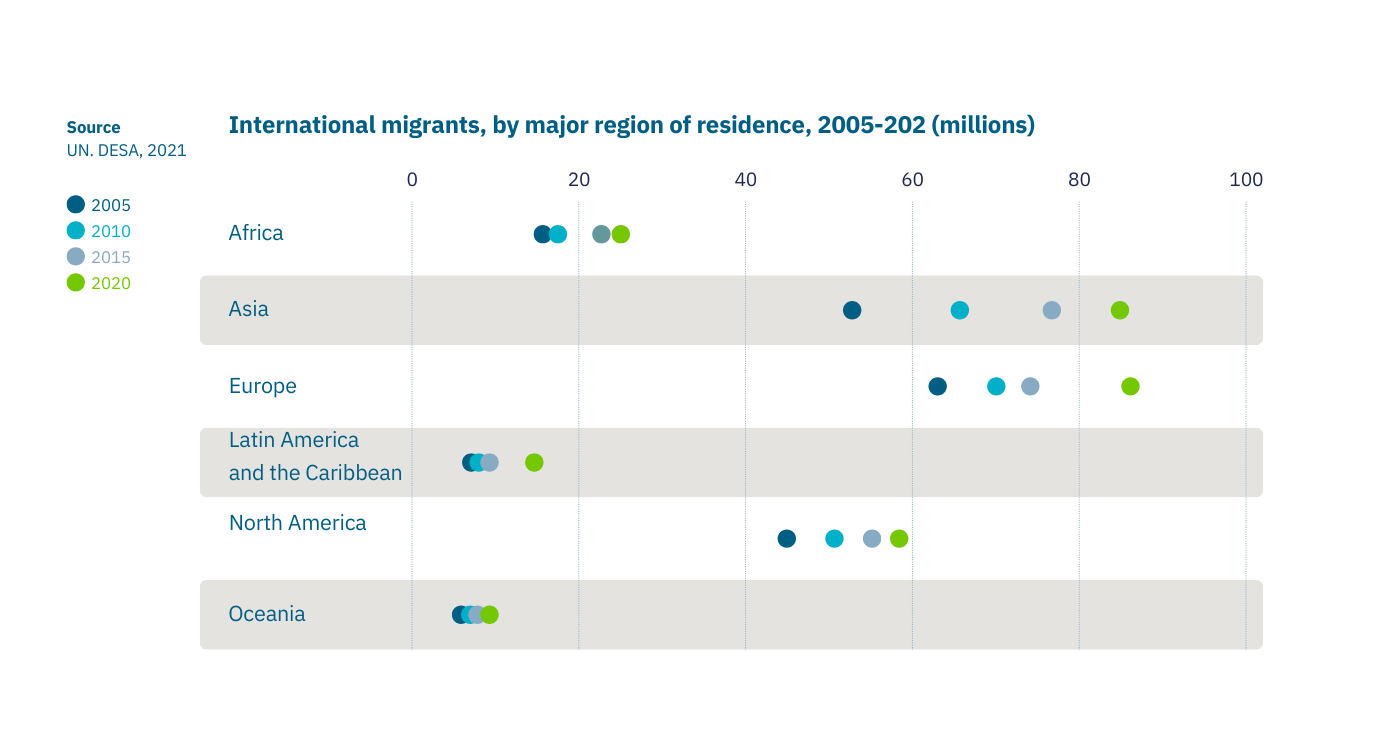
The Multifaceted Challenges of International Recruitment
Initiating international recruitment programs requires a nuanced understanding of the challenges involved. Beyond competitive salaries, companies may need to provide relocation transport, temporary accommodation, language training, cultural integration programs, and comprehensive healthcare, potentially extending to the migrant’s entire family. The complexities of immigration processes, varying legal frameworks, and the financial implications of international recruitment add further layers of consideration for companies venturing into this strategy.
Understanding the Global Talent Flow: Insights from Research
Most Attractive Destinations for International Migrants
UN data reveals that Europe stands as the most popular destination for international migrants, capturing 30.9% of the global migrant population. Asia closely follows with 30.5%, while North America receives 20.9%. Understanding these regional preferences is crucial for automotive companies devising international recruitment strategies.

Competitive Wages for Automotive Workers Worldwide
While migration decisions involve multifaceted considerations, salary remains a pivotal factor. For automotive workers seeking the highest salaries, the UK and USA emerge as top choices. Conversely, Poland and Hungary present less competitive opportunities within Europe, aligning more closely with salaries in Brazil. The intriguing case of Japan, with a lower ‘high wage’ but comparable average salary to countries like Germany and France, underscores the complexity of salary considerations in international recruitment.
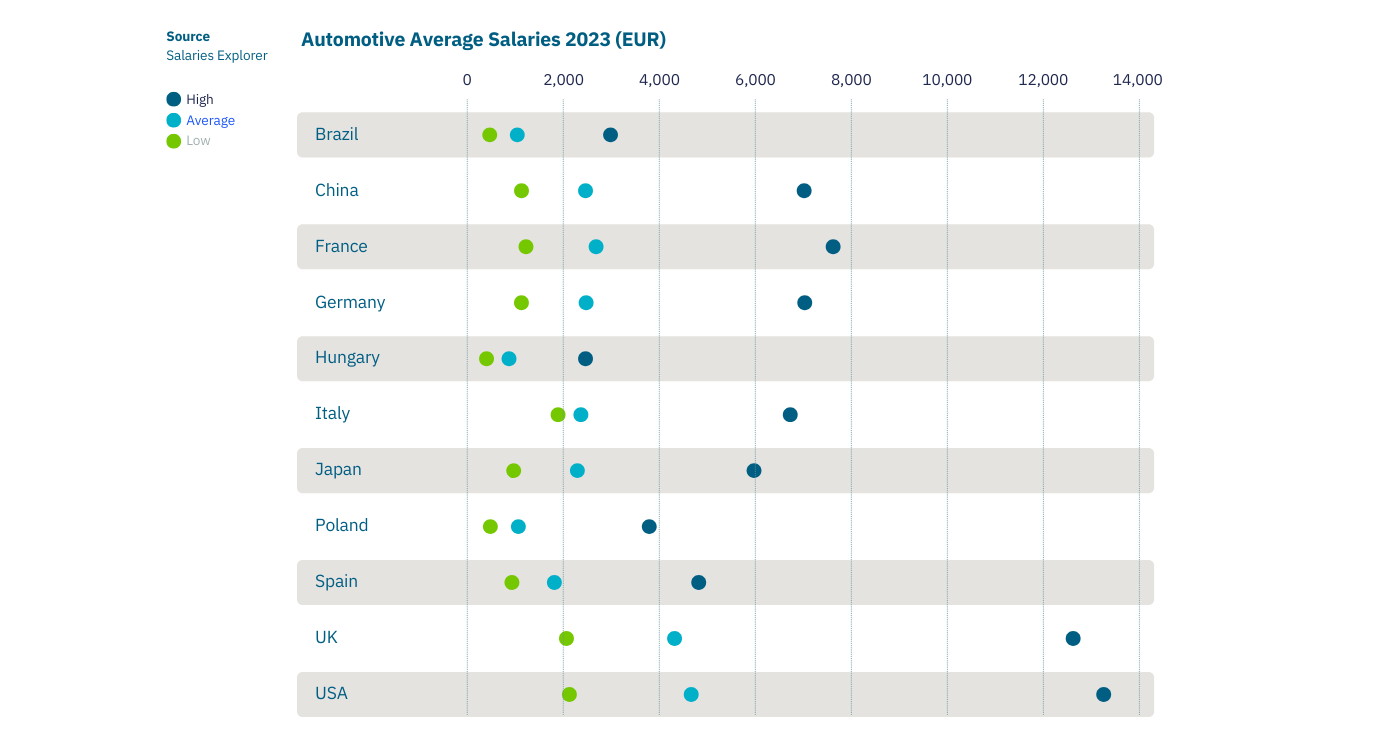
Common Challenges in International Recruitment: A Global Perspective
Language Barriers and Communication: A Universal Concern
Conducting international recruitment encounters common challenges across diverse countries. Language barriers and communication difficulties emerge as the most significant concern, identified by 42.4% of respondents. This underscores the importance of language programs for both existing and incoming staff.
Administrative Complexities and Legal Hurdles
Beyond linguistic challenges, the administrative costs and complexities of hiring migrant workers pose significant obstacles. Respondents cited concerns such as the complexity of immigration laws (34.8%), administrative burdens, and bureaucratic practices (32.6%), along with ensuring compliance with tax and social security obligations (29%). These challenges necessitate dedicated resources and a strategic approach to navigate the legal, financial, and administrative intricacies of international recruitment.
Regional Differences in Recruitment Challenges
While language issues consistently top the list of challenges in most countries, intriguing regional differences emerge. Japan, China, and Hungary prioritise the assessment of foreign qualifications. The USA distinguishes itself by identifying the balancing act between the need for international talent and the demands of the local workforce as a primary challenge.
In conclusion, the journey of international recruitment presents automotive companies with a promising yet complex route to address skills and labour shortages. Navigating the challenges of language, legal complexities, and varying recruitment landscapes demands a strategic approach. As the industry accelerates towards a global future, those companies that successfully navigate these challenges will not only tap into untapped talent pools but will also gain a competitive edge in the race towards innovation, diversity, and sustained growth.
Driving Change: Confronting Gender Equality Challenges in the Automotive Sector
Despite facing persistent challenges, the sector is awakening to the value that women bring, not only in terms of skills but also as influential consumers. The following explores the evolving landscape of gender equality in the automotive sector, investigating current perceptions, challenges, and the initiatives undertaken by companies to foster diversity and inclusion.
Understanding Barriers for Women in the Automotive Industry
Perceptions vs. Reality: Breaking Down the Barriers
While the automotive industry remains predominantly male-centric, our research sought to uncover the factors dissuading women from entering the sector. Respondents indicated that poor visibility of female leaders (38.4%), the perception of gender representation within companies (31.5%), and a lack of awareness and recruitment campaigns targeting women (27.1%) are key deterrents. Practical challenges such as work-life balance (35.1%) and career advancement inequality (34.4%) also play a role, suggesting that external perceptions align with practical obstacles.
Investing in Equality: An Industry Striving for Change?
Examining the broader landscape of organisational initiatives, the automotive sector appears to lag in investment in diversity, equity, and inclusion programs, ranking third from the bottom among sectors. The World Economic Forum’s Future of Jobs survey indicates that only 79% of organisations within the automotive sector invest in DEI programs aimed at achieving gender parity, reinforcing the need for increased commitment.
Closing the Gender Gap: Proactive Steps or a Lagging Progress?
Are Companies Actively Bridging the Gender Gap?
To gauge industry responsiveness, we inquired whether companies within the automotive sector are taking concrete actions to bridge the gender gap and encourage women to enter the field. Encouragingly, an average of 80% of respondents across countries affirmed that their companies are actively working toward achieving gender parity.
Global Variations in Focus on Gender Parity
While the majority of auto manufacturers across countries are committed to gender equality, variations exist. Brazil (96.4%) and China (93.5%) demonstrate the highest proportion of companies working towards gender parity, while Japan (80.1%) and Poland (78.6%) exhibit relatively lower engagement.
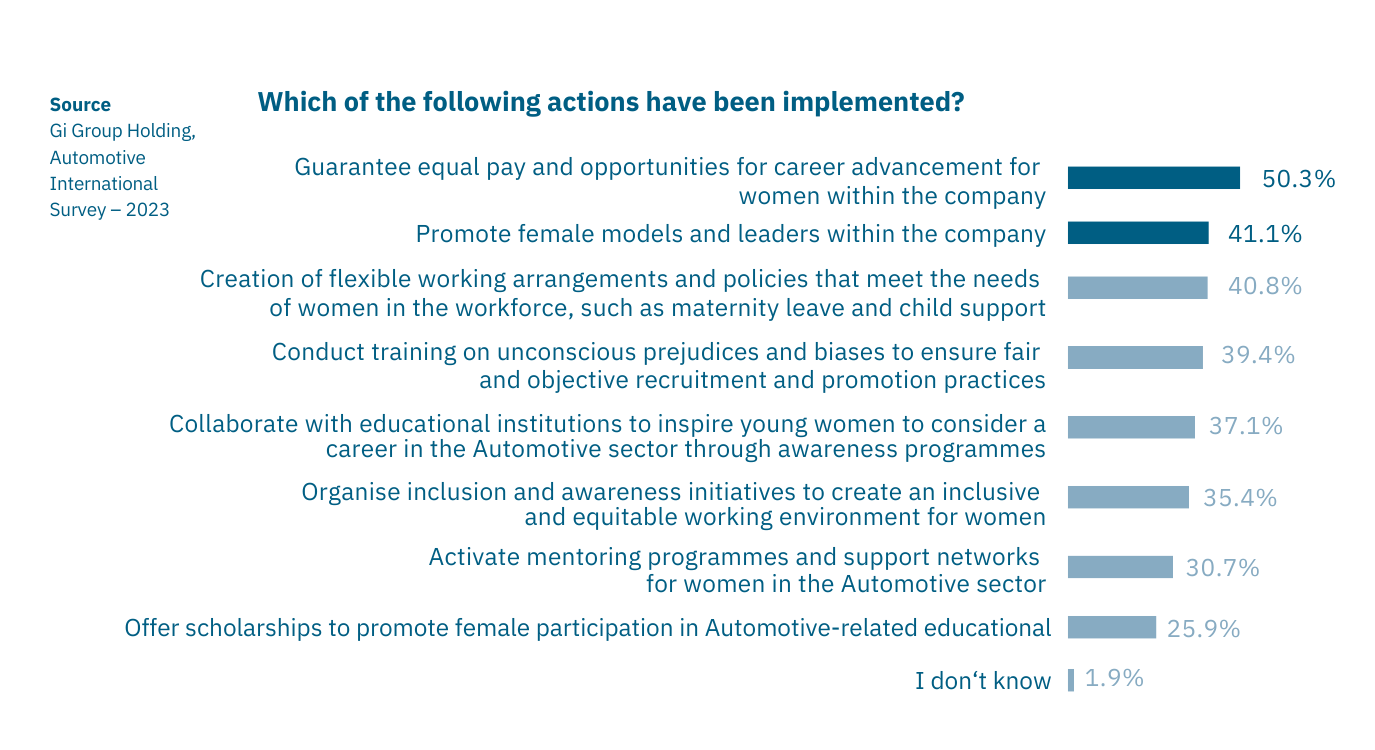
Initiatives to Drive Change: Transformative Actions by Automotive Companies
What Initiatives Are Companies Undertaking?
To understand the proactive steps being taken, respondents of our global research were questioned about the initiatives their companies are implementing. While progress is evident, the results highlight areas for improvement. Globally, only 50.3% of respondents reported their companies guaranteeing equal pay and opportunities for women, while 40.8% mentioned the provision of flexible working, maternity leave, and child support.
International Variations in Gender Equality Initiatives
Countries are adopting a similar blend of initiatives to foster gender equality, but some lead in specific areas. Italy focuses most on ensuring equal pay and opportunities for career advancement (66%), Hungary excels in training on unconscious biases and prejudices (72%), and Brazil leads in promoting female models and leaders within companies (56%).
The automotive sector is at a crossroads, recognising the imperative of gender equality not just as a societal goal but as a business necessity. While challenges persist, there is a palpable shift in the industry’s mindset, with companies increasingly acknowledging the benefits of diversity. As the sector navigates this transformative journey, it is not just about breaking stereotypes but also about reshaping the automotive landscape to be more inclusive, innovative, and reflective of the diverse world it serves.
The bottom line – Steering towards a brighter future
In conclusion, the automotive industry finds itself at a pivotal moment, marked by the convergence of technological advancements, workforce transformations, international recruitment challenges, and the imperative of gender equality. As the sector and automotive manufacturers adapt to a tech-driven revolution, navigating uncertainties and embracing change becomes the key to not just survival but thriving. From the integration of technology by blue-collar workers to the adaptive strategies of white-collar roles, the industry stands at the intersection of tradition and transformation. Recognizing the critical importance of skills, innovation, and diversity, automotive companies navigating the complexities of international recruitment are poised to unlock untapped talent pools and gain a competitive edge in the pursuit of innovation and sustained growth. Embracing the shift towards inclusivity, innovation, and diversity, the automotive sector charts a course for a future that goes beyond breaking stereotypes, reshaping itself into a more reflective, adaptive, and progressive industry that meets the diverse needs of the world it serves.
Buckle up; the journey has just begun.








